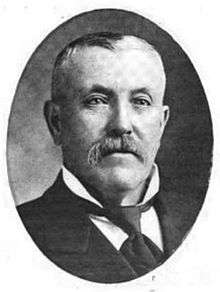Peter McCarthy (industrialist)
Peter McCarthy (24 November 1845 – 29 May 1919) was an American manufacturer, businessman and philanthropist from Troy, New York.[1]

Biography
Early life
Peter McCarthy was born in Troy, New York on November 24, 1845, to Catholic Irish immigrants Florence McCarthy and Mary Crowley. McCarthy grew up poor.[2] He was educated in Troy's public school system. After graduating Troy High School in 1863, he worked in the sash and bind business in Troy. In 1864 McCarthy traveled west to Clinton, Iowa and lived there for two years. He then moved to Durham, Pennsylvania and was employed by the safe manufacturer Lewis P. Lillie.[1][3] When he returned to Troy, New York, Peter and his brother Charles McCarthy founded C. & P. McCarthy and began trading in waste, rags, wool and cotton.[1][4] C. & P. McCarthy was located on Riverstreet.[5]
Marriage and personal life
On April 22, 1879, McCarthy married Julia F. Haley of Troy. They had ten children. McCarthy was also a member of the Catholic Club of New York[1] and gave to Catholic Charities.
Textile industry and Troy Waste Manufacturing
The Troy Waste Manufacturing Company developed out of C. & P. McCarthy.[6] The company obtained scraps from the local mills and processed them into new materials[7] It was incorporated in February 1883.[8] He served as president of the Troy Waste Manufacturing Company[6] and Faith Knitting Company. He was treasurer of the Hope Knitting Company of Cohoes, the Clover Knitting Company of Waterford, and the Wayside Knitting Company of Troy.[9] He was treasurer of the Troy Knitting Company.[3] In addition to dealing paper, wool, and cotton waste, Troy Waste Co. began manufacturing shoddies and cotton batting.[8]
Railroads and other business ventures
After his success with the Troy Waste Manufacturing Company, he began to branch out into the Railroad industry. He served as director for the Hudson Valley Railroad, Troy and Cohoes Railroad Company, Columbus, Marion and Bucyrus Railroad Company, and the Lansingburgh and Cohoes Railroad.[1][3][10] By 1900 he was director for the Troy Gas Light Company, National State Bank of Troy, International Pulp Company, Troy and West Troy Bridge Company, and Federal Signal Company. He was vice-president of the Troy Trust Company.[3][11]
The McCarthy Building
In 1883 he built the McCarthy Building.[6][12] It was destroyed by a fire in 1903, and he rebuilt the current McCarthy Building in the Central Troy Historic District in 1904.[13]
Philanthropy and the McCarthy Charities Inc.
McCarthy was a philanthropist and contributor to many charities in Troy, particularly to organizations focused on orphans and the poor.[14] He built the Seton Day Home run by the Sisters of Charity and the McCarthy Memorial Chapel. He was a notable benefactor of Saint Peter's Parish of Troy.[15] In 1917, two years before his death, he founded and endowed the McCarthy Charities, Incorporated to be a lasting fund.[2][14]
Politics
McCarthy was a republican and served in the United States Electoral College. He was Presidential Elector for New York in the 29th 1900 United States presidential election for William McKinley for President and for Theodore Roosevelt for Vice President of the United States.[16]
Legacy
The McCarthy Charities, Incorporated is a family foundation focused on improving the quality of life in Rensselaer County, especially in education, social services and housing. It is operated today by a Board of Directors composed of Peter McCarthy's direct descendants.[17][18]
References
- A Thousand American Men of Mark Today. American Men of Mark. 1917. p. 224.
- "Peter McCarthy Dead". New York Times. New York: Arthur Hays Sulzberger. 30 May 1919. Retrieved 9 March 2014.
- Thomas William Herringshaw (1919). Herringshaw's American Blue-book of Biography: Prominent Americans of ... American Publishers' Association. p. 300.
- "The Art of American Advertising, 1865–1910,". Business Card Index #11. Baker Library, Harvard Business School. 4 Dec 2013. Retrieved 8 March 2014.
- The American Stationer. Howard Lockwood. 1879. p. 13.
- Arthur James Weise (1886). The City of Troy and Its Vicinity. E. Green. pp. 326, 201.
- Spellen, Suzanne (4 Oct 2013). "A wave of renovation is removing Troy's Rust Belt decay to open the way for new urban economy and culture". New York Daily News. New York: Mortimer Zuckerman. Retrieved 9 March 2014.
- Arthur James Weise (1891). Troy's One Hundred Years, 1789-1889. W.H. Young. p. 417.
- George Baker Anderson (1897). Landmarks of Rensselaer county, New York. D. Mason & company. pp. 728–.
- New York (State). Board of Railroad Commissioners (1907). Annual Report of the Board of Railroad Commissioners of the State of New York for the Fiscal Year Ending ... Weed, Parsons and Company. p. 1381.
- Trust Companies of the United States; Statements of Condition. 1911. p. 228.
- Brian Nielsen; Becky Nielsen (2001). Troy in Vintage Postcards. Arcadia Publishing. p. 31. ISBN 978-0-7385-0903-7.
- Furniture World and Furniture Buyer and Decorator. Towse Publishing Company. 1903. p. 25.
- The Catholic Charities Review. 1918. p. 55.
- Charles George Herbermann; Edward Aloysius Pace; Condé Bénoist Pallen; Thomas Joseph Shahan; John Joseph Wynne (1907). The Catholic Encyclopedia: An International Work of Reference on the Constitution, Doctrine, Discipline, and History of the Catholic Church. Encyclopedia Press, Incorporated. p. 258.
- "Electoral Colleges Meet" (PDF). New York Times. New York: Arthur Hays Sulzberger. 15 Jan 1901. Retrieved 9 March 2014.
- "Business Directory - The McCarthy Charities". Rensselaer County Regional Chamber of Commerce. Rensselaer Chamber of Commerce. 2009. Retrieved 8 March 2014.
- "New Grantmakers: School, Work, Family, and Foundation Too". The Association of Small Foundations. Matrix Group Intl, Inc. 2014. Retrieved 12 March 2014.